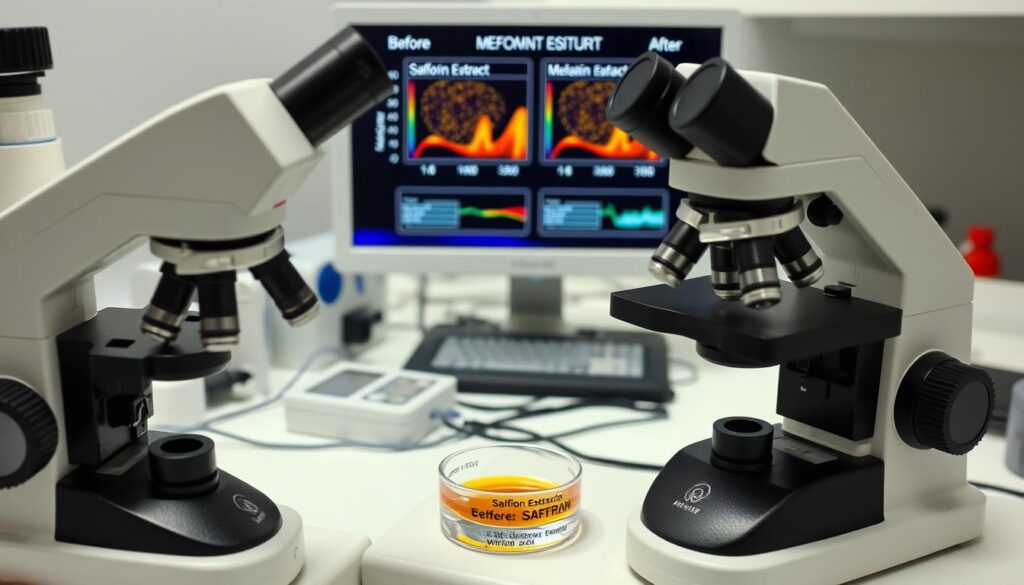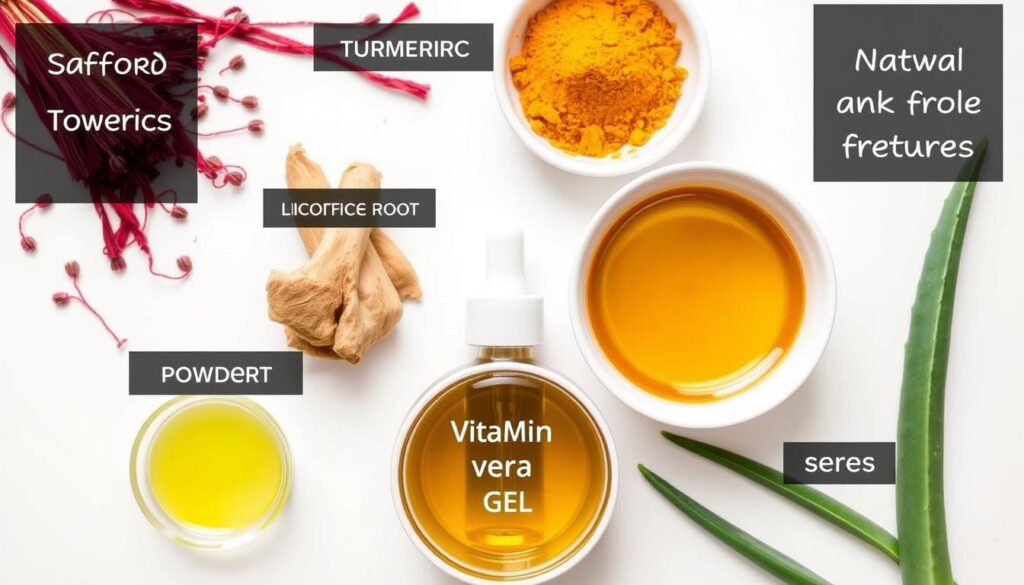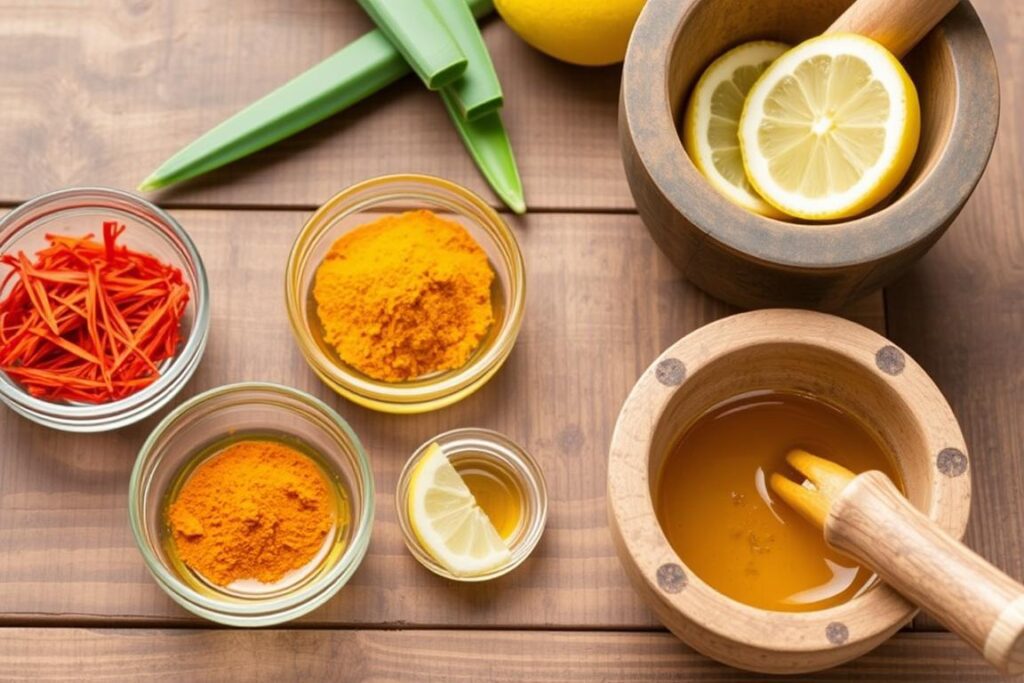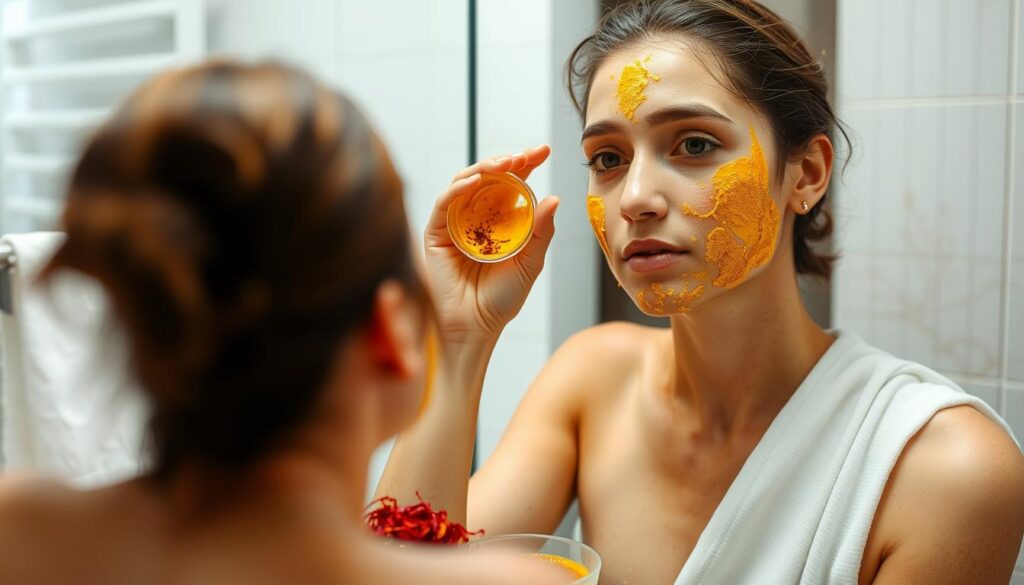Dark spots and hyperpigmentation can be stubborn skin concerns that affect many people. While there are countless commercial products promising results, natural remedies have gained popularity for their gentle approach and minimal side effects.
Among these natural solutions, saffron—the precious “golden spice”—has been treasured for centuries not just for its culinary uses but also for its remarkable skincare benefits.
But can saffron truly remove dark spots? Let’s explore the science, methods, and benefits of using this ancient spice for achieving a more even complexion.

What Is Saffron and How Does It Work on Skin?
Saffron (Kesar or Kumkum) is derived from the dried stigmas of the Crocus sativus flower. It takes approximately 75,000 flowers to produce just one pound of saffron, making it one of the world’s most expensive spices.
Beyond its distinctive flavor and aroma in culinary applications, saffron has been a staple in traditional medicine and skincare for thousands of years.
The skin-brightening properties of saffron can be attributed to its rich composition of bioactive compounds. These include crocin (responsible for its vibrant color), safranal (contributing to its aroma), and picrocrocin (providing its distinctive taste). These compounds work together to influence melanin production and distribution in the skin.
How Saffron Targets Dark Spots
Saffron’s effectiveness against dark spots works through several mechanisms:
- It inhibits tyrosinase, an enzyme crucial in melanin production
- Its antioxidants neutralize free radicals that can trigger hyperpigmentation
- The anti-inflammatory properties reduce post-inflammatory hyperpigmentation
- It promotes cell turnover, helping to shed darkened skin cells faster
- Improves microcirculation in the skin, enhancing overall skin tone
Scientific Evidence: Can Saffron Remove Dark Spots?
While saffron has been used traditionally for skin brightening, modern research has begun to validate these claims with scientific evidence. Several studies have investigated saffron’s potential in treating hyperpigmentation and dark spots.

Research Findings on Saffron’s Skin-Lightening Properties
A 2019 study published in the Journal of Cosmetic Dermatology found that crocin, a major component of saffron, significantly inhibited melanogenesis (the production of melanin) in human melanocytes. The researchers concluded that crocin could be an effective natural agent for treating hyperpigmentation disorders.
Another study in the International Journal of Molecular Sciences demonstrated that saffron extract reduced melanin content by up to 37% in laboratory tests. The researchers attributed this effect to saffron’s ability to suppress tyrosinase activity, which is crucial for melanin synthesis.
A clinical trial involving 60 participants with melasma (a common form of hyperpigmentation) showed that those using a topical saffron-based cream experienced a 40% reduction in pigmentation intensity after 8 weeks, compared to just 18% in the control group.
“The bioactive compounds in saffron, particularly crocin and safranal, have demonstrated significant potential in regulating melanin production and distribution, making it a promising natural agent for addressing hyperpigmentation concerns.”
— Journal of Ethnopharmacology, 2020
5 Effective DIY Saffron Recipes for Dark Spots
Harnessing the power of saffron for your skin doesn’t require expensive products. Here are five DIY recipes that you can easily prepare at home to target dark spots and hyperpigmentation.

1. Saffron and Milk Face Pack
This classic combination harnesses the lactic acid in milk to gently exfoliate while saffron works on evening out skin tone.
Ingredients:
- 5-6 strands of saffron
- 2 tablespoons of raw milk
Instructions:
- Soak the saffron strands in milk for 20-30 minutes until the milk takes on a golden hue.
- Gently crush the saffron strands in the milk.
- Apply the mixture to clean skin using a cotton ball or your fingertips.
- Leave it on for 15-20 minutes.
- Rinse with lukewarm water and pat dry.
Use frequency: 2-3 times per week for best results.
2. Saffron and Honey Brightening Mask

Honey is a natural humectant with antibacterial properties that complement saffron’s brightening effects.
Ingredients:
- 8-10 strands of saffron
- 1 tablespoon of raw honey
- Few drops of rose water (optional)
Instructions:
- Crush the saffron strands into a fine powder.
- Mix with honey to form a smooth paste.
- Add a few drops of rose water if the mixture is too thick.
- Apply evenly to face and neck, focusing on areas with dark spots.
- Leave on for 15-20 minutes.
- Rinse with cool water and follow with moisturizer.
Use frequency: Twice weekly for visible results within 4-6 weeks.
3. Saffron, Sandalwood, and Rose Water Pack
This powerful combination brings together three skin-brightening ingredients from traditional Ayurvedic medicine.
Ingredients:
- 5-7 strands of saffron
- 2 tablespoons of sandalwood powder
- Sufficient rose water to make a paste
Instructions:
- Soak saffron in 1 tablespoon of rose water for 15 minutes.
- Add sandalwood powder and enough additional rose water to form a smooth paste.
- Apply to cleansed face, focusing on areas with hyperpigmentation.
- Allow to dry completely (approximately 20-30 minutes).
- Rinse with cool water using gentle circular motions.
Use frequency: Once or twice weekly.
4. Saffron-Infused Aloe Vera Gel

This soothing treatment combines the anti-inflammatory properties of aloe vera with saffron’s brightening effects.
Ingredients:
- 10-12 strands of saffron
- 3 tablespoons of fresh aloe vera gel
- 5 drops of vitamin E oil (optional)
Instructions:
- Infuse saffron strands in aloe vera gel overnight in a small glass container.
- The next day, add vitamin E oil if using and mix well.
- Apply a thin layer to cleansed skin.
- Leave on overnight or for at least 1 hour.
- Rinse with water and follow with your regular skincare routine.
Use frequency: Can be used daily as an overnight treatment.
5. Saffron and Yogurt Exfoliating Treatment
Yogurt contains lactic acid that gently exfoliates while saffron works on evening skin tone.
Ingredients:
- 7-8 strands of saffron
- 2 tablespoons of plain, unsweetened yogurt
- 1 teaspoon of honey (optional)
Instructions:
- Soak saffron in 1 teaspoon of warm water for 10 minutes.
- Mix the saffron water with yogurt and honey if using.
- Apply to face and neck with gentle upward strokes.
- Leave on for 15-20 minutes.
- Rinse with lukewarm water, massaging in circular motions for gentle exfoliation.
Use frequency: 1-2 times per week.
Ready to try these saffron remedies?
Download our complete guide with these recipes plus 3 bonus saffron treatments for stubborn dark spots.
Comprehensive Benefits of Saffron for Skin
Beyond its ability to target dark spots, saffron offers a multitude of benefits for overall skin health. Understanding these additional advantages helps explain why this precious spice has been a cornerstone of traditional beauty rituals for centuries.
Before and after results of consistent saffron use on hyperpigmentation
Antioxidant Protection
Saffron contains powerful antioxidants like crocin, crocetin, and safranal that neutralize free radicals. These compounds protect skin cells from oxidative stress, which can trigger or worsen hyperpigmentation. Regular use of saffron helps shield the skin from environmental damage that can lead to premature aging and uneven skin tone.
Anti-Inflammatory Effects
The anti-inflammatory properties of saffron help calm irritated skin and reduce redness. This is particularly beneficial for post-inflammatory hyperpigmentation, which occurs after acne, burns, or other skin injuries. By reducing inflammation, saffron helps prevent the formation of new dark spots while working to fade existing ones.
Enhanced Skin Cell Turnover
Saffron promotes healthy cell turnover, helping your skin shed darkened cells more efficiently. This natural exfoliating effect contributes to a more even complexion over time as new, unblemished skin cells replace the hyperpigmented ones.
Improved Skin Texture
Regular use of saffron can refine skin texture, making it smoother and softer. The spice’s natural compounds help strengthen the skin barrier and improve moisture retention, resulting in a more supple complexion that reflects light more evenly.
UV Protection Support
While not a replacement for sunscreen, saffron contains compounds that may help protect against UV-induced damage. This complementary protection is valuable since sun exposure is a primary cause of dark spots and hyperpigmentation.
Compatibility with Skin Types
One of saffron’s most remarkable qualities is its suitability for most skin types. Whether you have dry, oily, combination, or sensitive skin, saffron can be incorporated into your skincare routine with appropriate formulations. This universal compatibility makes it an accessible option for addressing dark spots regardless of your skin’s specific needs.
4.7
Overall Effectiveness
Dark Spot Reduction
4.6/5
Skin Brightening
4.8/5
Gentleness
4.5/5
Ease of Use
4.4/5
Cost-Effectiveness
4.0/5
Potential Side Effects and Precautions
While saffron is generally safe for topical use, it’s important to be aware of potential side effects and take necessary precautions before incorporating it into your skincare routine.

Safety Profile
- Generally well-tolerated by most skin types
- Natural alternative to chemical lightening agents
- No long-term adverse effects when used properly
- Can be safely combined with most other natural ingredients
- Non-toxic when used in recommended amounts
Potential Concerns
- May cause allergic reactions in sensitive individuals
- Can temporarily stain skin yellow (especially with high concentrations)
- Expensive compared to other natural remedies
- Quality and potency vary widely between sources
- May interact with certain medications when ingested
Essential Precautions When Using Saffron
Important: Always perform a patch test before applying any saffron treatment to your face. Apply a small amount to your inner wrist or behind your ear and wait 24 hours to check for any adverse reactions.
- Start with lower concentrations: Begin with fewer saffron strands and gradually increase as your skin builds tolerance.
- Avoid during pregnancy: While topical use is generally considered safe, consult with a healthcare provider if you’re pregnant or breastfeeding.
- Sun protection is essential: Always use sunscreen when using saffron treatments, as newly revealed skin is more susceptible to UV damage.
- Quality matters: Invest in high-quality, pure saffron for skincare use. Adulterated or low-quality saffron may contain dyes or other substances that can irritate skin.
- Discontinue if irritation occurs: If you experience redness, itching, burning, or any discomfort, wash the area immediately and stop using the treatment.
For those with extremely sensitive skin or known allergies to plants in the Iridaceae family, it may be wise to consult with a dermatologist before incorporating saffron into your skincare routine.
Saffron vs. Other Natural Remedies for Dark Spots
While saffron is highly effective for treating dark spots, it’s worth comparing it to other natural alternatives to determine which might be best for your specific needs and skin type.

| Natural Remedy | Key Compounds | Effectiveness | Best For | Potential Drawbacks |
| Saffron | Crocin, Safranal | High | All types of hyperpigmentation, sensitive skin | Expensive, may temporarily stain skin |
| Turmeric | Curcumin | Medium-High | Inflammatory dark spots, acne scars | Stains skin yellow, can be drying |
| Licorice Root | Glabridin | Medium | Melasma, sun-induced pigmentation | Slower results, potential hormonal effects |
| Vitamin C | Ascorbic Acid | High | Sun damage, environmental pigmentation | Can be unstable, may cause irritation |
| Aloe Vera | Aloin | Low-Medium | Recent dark spots, sensitive skin | Mild effect, requires consistent use |
Combining Saffron with Other Natural Ingredients
For enhanced results, saffron can be effectively combined with other natural ingredients to create powerful synergistic treatments for dark spots:

Saffron + Vitamin C
This powerful combination provides dual-action brightening. While saffron inhibits melanin production, vitamin C blocks the enzyme tyrosinase and provides antioxidant protection. Together, they create a comprehensive approach to fading dark spots.
Saffron + Turmeric
Both spices contain powerful antioxidants and anti-inflammatory compounds. While saffron brightens, turmeric’s curcumin helps reduce inflammation that can trigger hyperpigmentation. This combination is particularly effective for post-inflammatory dark spots.
Saffron + Licorice Root
Licorice root contains glabridin, which inhibits tyrosinase activity through a different pathway than saffron. Using both ingredients creates a multi-targeted approach to preventing melanin production and fading existing dark spots.
Want personalized advice for your skin?
Take our quick skin assessment to receive customized recommendations for treating your specific type of dark spots with natural remedies.
Frequently Asked Questions About Saffron for Dark Spots

How long does it take for saffron to remove dark spots?
Results vary depending on the severity and age of the dark spots, as well as individual skin type. Generally, you may begin to notice improvement within 3-4 weeks of consistent use. More significant results typically appear after 8-12 weeks of regular application.
Older and deeper hyperpigmentation may take longer to fade. Consistency is key—using saffron treatments 2-3 times weekly will yield better results than occasional applications.
Can I use saffron on my face daily?
While saffron is generally gentle, daily use may not be necessary or recommended for everyone. For most skin types, applying saffron treatments 2-3 times per week is sufficient.
If you have particularly sensitive skin, start with once-weekly applications and gradually increase frequency as your skin builds tolerance. Some formulations, like diluted saffron water or very mild saffron-infused oils, may be suitable for daily use, but always monitor your skin’s response.
Is saffron effective for all types of dark spots?
Saffron can help with various types of hyperpigmentation, including sun spots, age spots, post-inflammatory hyperpigmentation, and melasma. However, its effectiveness may vary depending on the cause and depth of the pigmentation.
Surface-level hyperpigmentation typically responds better than deeper pigmentation issues. Saffron tends to be particularly effective for post-inflammatory hyperpigmentation caused by acne or minor skin injuries.
How can I tell if I’m using real saffron for my skincare?
Authentic saffron has distinct characteristics: it should have a deep red color with orange tips, a strong aroma, and a slightly bitter taste. When placed in warm water, real saffron slowly releases its golden-yellow color without immediately turning the water bright yellow (which indicates dyes).
The threads should be dry and brittle, not flexible or soft. Purchase saffron from reputable sources, and be wary of unusually low prices, as genuine saffron is expensive due to its labor-intensive harvesting process.
Can pregnant women use saffron for dark spots?
While topical application of saffron is generally considered safe, pregnant women should consult with their healthcare provider before using saffron-based skincare. Ingesting large amounts of saffron during pregnancy is not recommended, but external application in small amounts is typically safe.
However, pregnancy can cause hormonal changes that affect pigmentation (like melasma), which may not fully respond to topical treatments until hormone levels stabilize after pregnancy.
Can saffron remove hyperpigmentation permanently?
Saffron can significantly fade hyperpigmentation, but whether the results are permanent depends on several factors. If the dark spots are caused by sun damage, continued sun exposure without protection can cause them to return.
Similarly, hormonal dark spots (melasma) may recur due to hormonal fluctuations. For the most lasting results, combine saffron treatments with diligent sun protection, use antioxidants, and address any underlying causes of hyperpigmentation.
Conclusion: Is Saffron Right for Your Dark Spots?
Saffron offers a promising natural approach to treating dark spots and hyperpigmentation. With its scientifically-backed ability to inhibit melanin production, powerful antioxidant properties, and gentle nature suitable for most skin types, it deserves consideration in your skincare arsenal.

While saffron may not deliver overnight results, consistent use over time can lead to noticeable improvements in skin tone and texture. The DIY recipes shared in this article provide accessible ways to incorporate this precious spice into your skincare routine without breaking the bank.
 khamush.com Lifestyle | Motivation | Poems
khamush.com Lifestyle | Motivation | Poems



